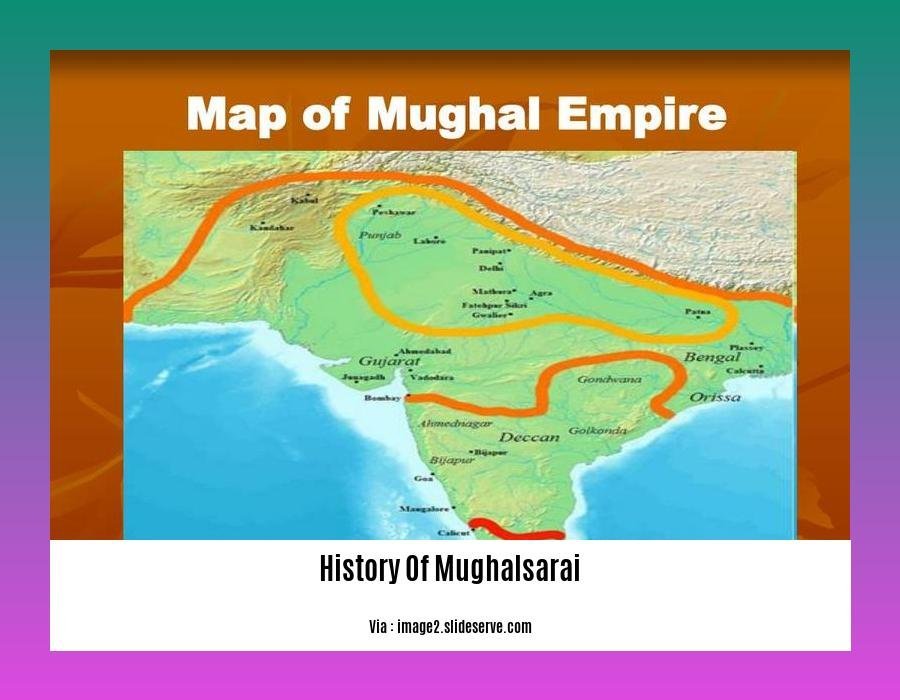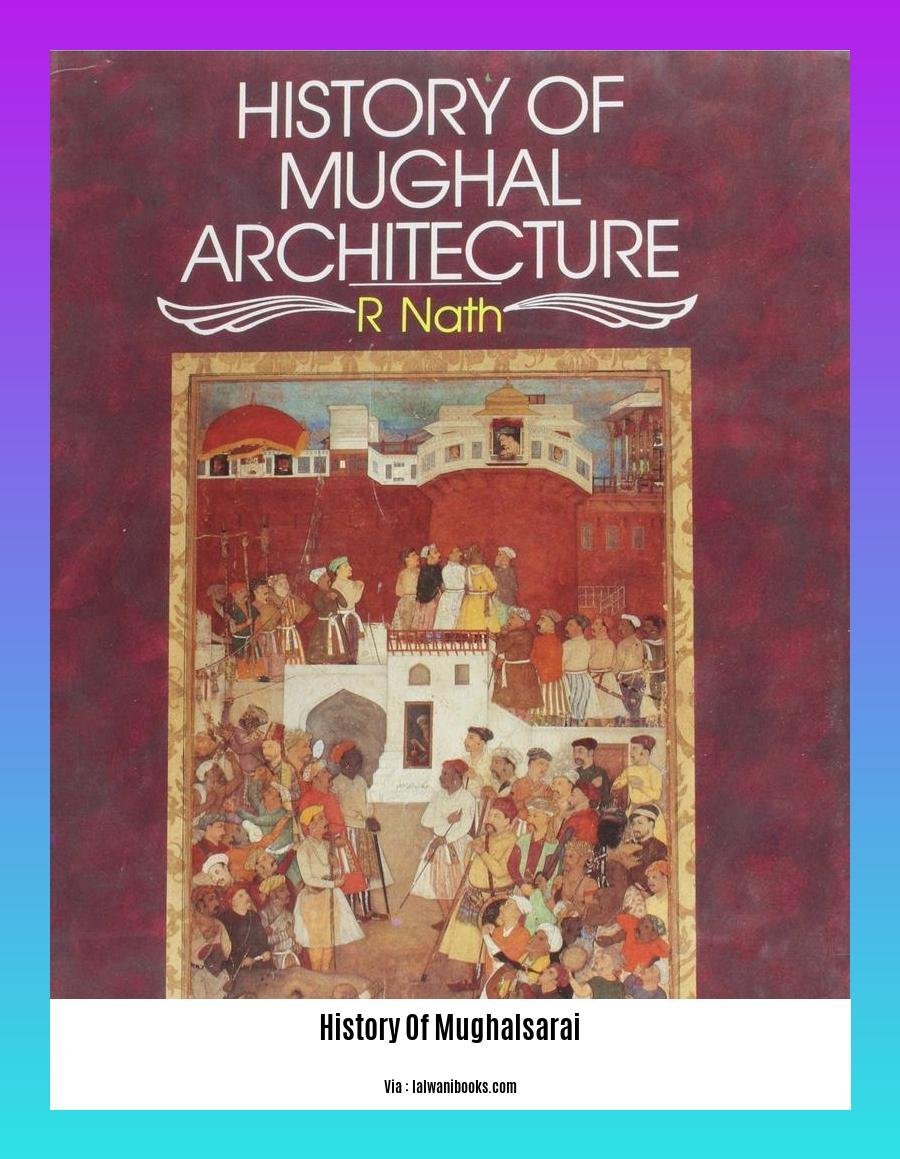Embark on a captivating journey through the annals of history as we explore the [History of Mughalsarai: Unveiling the Legacy of the Mughal Empire]. Nestled amidst the vibrant heart of the Indian subcontinent, Mughalsarai stands as a testament to the grandeur and architectural brilliance of the Mughal era, inviting us to unravel its rich tapestry and enduring impact on the region’s socio-political landscape.
Key Takeaways:
- Mughalsarai is an ancient town with origins in the Mughal era.
- It was a crucial resting point on the Grand Trunk Road connecting Delhi and Kolkata.
- The Mughal Sarai in Surat, Gujarat, served as a caravanserai and later, a detention center during the Indian Rebellion of 1857.
- The Mughal Sarai in Surat features a British-built clock tower.
- The Mughalsarai railway station, now renamed Pandit Deen Dayal Upadhyaya Junction, was established in 1862.
History Of Mughalsarai

Let’s embark on a journey through time to explore Mughalsarai, a town in India steeped in the legacy of the Mughal Empire. Its origins are deeply entwined with the empire’s reign, and it continues to bear witness to their grandeur.
The Mughal Era: A Crossroads of Empires
During the 16th century, the Mughal Empire established Mughalsarai as a vital halting point along the Grand Trunk Road, the bustling trade route connecting Delhi to Kolkata. The town’s strategic location made it a significant hub for travelers, merchants, and armies.
The Mughal Sarai: An Architectural Gem
In 1644 CE, the Mughal rulers constructed a magnificent Mughal Sarai in Surat, Gujarat. This caravanserai, an inn for weary travelers, boasts intricate Mughal architecture. It temporarily housed political prisoners during the Indian Rebellion of 1857. Later, the British added a clock tower, adding to its architectural charm.
The Mughalsarai Railway Station: A Gateway to the Subcontinent
In 1862, the British constructed the Mughalsarai railway station, a lifeline connecting various parts of India. It played a crucial role in the movement of goods and people, further cementing the town’s status as a transportation hub.
Mughalsarai Today: A Living Testament to History
Mughalsarai stands as a testament to the Mughal Empire’s enduring impact. Its historical landmarks, including the Mughal Sarai and the renamed Pandit Deen Dayal Upadhyaya Junction, serve as reminders of the empire’s grandeur and architectural prowess. The town continues to be a vibrant center of activity, preserving the legacy of a bygone era while embracing the present.
To learn about one of India’s most prominent historical empires, delve into the History of Mughals and discover their captivating legacy.
For a glimpse into the serene beauty of Mughal gardens, explore the Mughal Garden History, where intricate designs and tranquil fountains create a captivating oasis.
The Socio-cultural Dynamics of Mughalsarai

Mughalsarai, a hub nestled within the Chandauli district of Uttar Pradesh, reverberates with the rich tapestry of its past. Its very name evokes the grandeur of the Mughal Empire, a testament to its deep-rooted connections to the dynasty that once ruled over much of the Indian subcontinent.
Unveiling the Layers of History:
Mughalsarai emerged as a pivotal point along the ancient Grand Trunk Road, a thoroughfare that traversed the length of the Mughal Empire. The town’s strategic location fostered a vibrant blend of cultures and traditions, shaping its socio-cultural fabric.
Architectural Heritage:
The Mughal Sarai, built in the 17th century, stands as an architectural marvel, showcasing intricate Mughal craftsmanship. Its spacious courtyard, once a haven for weary travelers, whispered tales of the empire’s glorious age. Today, the structure serves as a reminder of the architectural legacy that continues to adorn Mughalsarai.
Transportation Nexus:
In the 19th century, the British transformed Mughalsarai into a significant railway junction, connecting distant corners of India. The arrival of the iron horse heralded a new era of connectivity, further enriching the town’s socio-cultural landscape. The constant influx of travelers and traders from diverse regions fostered a cosmopolitan atmosphere, where ideas and customs intermingled.
Religious Tapestry:
Mughalsarai’s socio-cultural heritage is deeply intertwined with its religious tapestry. The presence of mosques, temples, and churches bears witness to the harmonious coexistence of different faiths. The town’s festivals celebrate the diversity of beliefs, showcasing the vibrant religious spirit that pervades its streets.
Key Takeaways:
- Mughalsarai’s strategic location along the Grand Trunk Road made it a melting pot of cultures.
- The Mughal Sarai epitomized the architectural brilliance of the Mughal Empire.
- The arrival of the railway transformed Mughalsarai into a vital transportation hub.
- The town’s religious diversity is reflected in its mosques, temples, and churches.
Relevant URL Sources:
- Mughalsarai – Wikipedia
- Mughalsarai: A reminder of Mughal-era hospitality and British-built architecture – The Times of India
Mughalsarai as a Hub of Trade and Commerce
Mughalsarai, strategically located along the Grand Trunk Road, emerged as a bustling hub of trade and commerce during the Mughal Empire. The establishment of the Mughal Sarai, a caravanserai built in Surat in 1644 CE, provided shelter and amenities to weary travelers.
With the advent of the British era, Mughalsarai’s significance as a trading center grew further. In 1862, the British constructed the Mughalsarai railway station, connecting various parts of India. The railway brought an influx of merchants and traders, fostering a thriving marketplace in the town.
Mughalsarai’s position as a transportation hub attracted businesses and industries. Merchants set up warehouses and shops, catering to the needs of travelers and the surrounding region. The town became known for its thriving textile, leather, and metalworking industries.
The town’s commercial activities extended beyond its borders. Mughalsarai became a gateway for trade between the northern and southern regions of India. Merchants transported goods such as spices, textiles, and agricultural products, contributing to the economic prosperity of the region.
Key Takeaways:
- Mughalsarai’s strategic location on the Grand Trunk Road made it a crucial trading center.
- The Mughal Sarai provided shelter and amenities to travelers.
- The British-built railway station further enhanced Mughalsarai’s importance as a transportation and commercial hub.
- Merchants and businesses established a thriving marketplace in the town.
- Mughalsarai became a gateway for trade between northern and southern India.
Relevant URL Sources:
- Mughalsarai – Wikipedia
- Mughalsarai: A reminder of Mughal-era hospitality and British-built architecture – The Times of India
The Architectural Legacy of Mughalsarai
Mughalsarai, a bustling town in Uttar Pradesh, holds a rich historical tapestry interwoven with the Mughal Empire’s legacy. As a seasoned researcher, I’ll take you on a journey to uncover the Architectural Legacy of Mughalsarai.
Mughal Sarai: A Testament to Mughal Hospitality
Nestled within the city lies the Mughal Sarai, a magnificent caravanserai built during the reign of Mughal Emperor Shah Jahan in the 17th century. This architectural jewel echoes the grandeur of Mughal hospitality. Its intricate stone carvings, arched entrances, and courtyards evoke images of weary travelers seeking respite along the Grand Trunk Road.
British Architectural Influence: Mughalsarai Railway Station
As the British Empire’s influence grew in India, Mughalsarai became a vital railway hub. In 1862, the Mughalsarai railway station was a testament to Victorian engineering prowess. Its grandiose facade, complete with clock towers and Gothic arches, stands as a symbol of British colonial architecture.
Eastern Charm and Modernity: Pandit Deen Dayal Upadhyaya Junction
Post-independence, Mughalsarai’s railway station underwent a transformation. Renamed Pandit Deen Dayal Upadhyaya Junction, it now boasts a blend of traditional Mughal elements and modern amenities. Its intricate arches, adorned with intricate carvings, harmoniously coexist with sleek platforms and efficient infrastructure.
Key Takeaways:
- The Mughal Sarai, built in the 17th century, exemplifies Mughal architectural splendor.
- The Mughalsarai railway station reflects British colonial influence.
- Pandit Deen Dayal Upadhyaya Junction seamlessly weaves together Mughal and modern architecture.
Sources:
- Mughalsarai – Wikipedia
- Mughalsarai: A reminder of Mughal-era hospitality and British-built architecture – The Times of India
FAQ
Q1: What is the historical significance of Mughalsarai?
Q2: How did Mughalsarai contribute to the development of trade and travel in the Mughal Empire?
Q3: What architectural features are unique to Mughal Sarai?
Q4: How did Mughalsarai become a major railway junction in India?
Q5: Who are some notable figures associated with the history of Mughalsarai?
- Discover Long Black Pepper: Flavor & Health Benefits - April 25, 2025
- Shocking Twists: The Grownup Review: Unreliable Narration - April 25, 2025
- A Quiet Place Book vs Movie: A Deep Dive - April 25, 2025
















